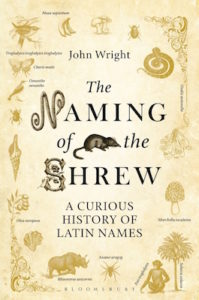Merriam Webster defines taxonomy as
1: the study of the general principles of scientific classification: systematics
2: classification; especially: orderly classification of plants and animals according to their presumed natural relationships
Many people, including a sizable portion of naturalists, might add a third definition:
3: the seemingly random attachment of names to plants and animals in a language no one speaks anymore; see also impenetrable, confusing
While it is to be granted that the taxonomic classification and its associated rules of naming can be a bit convoluted when viewed from the outside, in all fairness it is positively Byzantine when viewed from the inside. Even so, it is certainly not random. Indeed, without it, and the centuries of work put to developing and refining its practices by some of humanity’s most inquisitive minds, it would be difficult if not wholly impossible to study the living world. The challenge is just how one new to it can come to gain an understanding of it and its practices in the first place.
As with learning most any complex subject, it is always best to find one well versed in it who also possesses a good sense of humor so as to be able to present what might otherwise be quite strong medicine with the spoon-full of sugar needed to make it much more palatable. And when it comes to the naming of creatures and their arrangement into delineated – sometime well, at least – and thus useful groups, I have yet to find anyone better suited to the task than John Wright and his new book The Naming of the Shrew: A Curious History of Latin Names.
Wright, a Fellow of the Linnaean Society, and author of the River Cottage Handbooks Mushrooms, Edible Seashore
and Hedgerow
(and, for what it’s worth, Booze
), approaches his subject not by focusing on how it is supposed to work but rather by providing a wealth of short vignettes of how it has worked (or, in some cases, spectacularly failed). How, for example, a species of land-dwelling mole came to be named aquaticus, or why the Western Lowland Gorilla bears the seemingly redundant ad absurdum scientific name Gorilla gorilla (wait for it…) gorilla. Indeed, difficult as it is to believe, Wright’s recounting of some of more unusual, peculiar, and at times even obscene names that have been created over the years will actually bring the reader not just to chuckle quietly but to laugh unrestrainedly and loudly.
Then, once the reader has become not just comfortable with the terminology used in naming but through the consciously imperceptible repetition of it in the course of the vignettes, actually understanding it, Wright moves on to the history of the development of and reasoning behind classification systems – including a remarkably detailed chapter in which he presents brief biographies of the pertinent contributors to that history throughout the centuries. Finally, he concludes with an overview of how new systems of classification are being developed; systems that while perhaps more accurate may – for those of a poetical nature (a group that includes the author and, I’m not at all ashamed to declare, myself) – prevent some of the colorful, charming, and sometimes simply funny quirks that made Wright’s writing of The Naming of the Shrew possible.
I highly recommend The Naming of the Shrew to those new to taxonomic classification as well as those who may already be somewhat familiar with it but who would like to increase further their understanding of it. Those well versed in it may find some of the material it contains to be already known to them, yet they should also consider reading Wright’s book for the interesting and sometimes extraordinarily funny anecdotal information on particular cases it contains.
 Title: The Naming of the Shrew: A Curious History of Latin Names
Title: The Naming of the Shrew: A Curious History of Latin Names
Author: John Wright
Publisher: Bloomsbury
Date: 20 January 2015
Format: Hardback
Pages: 320 pp.
ISBN: 9781408816981
In accordance with Federal Trade Commission 16 CFR Part 255, it is disclosed that the copy of the book read in order to produce this review was provided gratis to the reviewer by the publisher.
